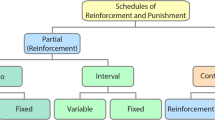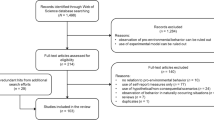Abstract
It is suggested that the number of protest responses in stated preference surveys depends, inter alia, on the valuation method used. Choice Experiments (CE) are said to generate a lower number of protest responses than Contingent Valuation (CV). However, no comparison of both methods with respect to protest responses has been conducted to date. We used both CE and CV in a survey on forest biodiversity in two German regions. Protest beliefs were measured for all respondents irrespective of whether they were willing to pay or not. The results show no clear pattern of differences between CE and CV regarding protest beliefs and protest responses. Using an attitude scale based on respondents’ protest beliefs, we see a significant negative effect of this attitude on willingness to pay in both methods. However, in one of the two study regions, the effect is weaker in CE than in CV.
Similar content being viewed by others
References
Allison PD (1999). Comparing logit and probit coefficients across groups. Sociol Method Res 28(2): 186–208
Bateman IJ, Carson RT, Day B, Hanemann WM, Hanley N, Hett T, Jones-Lee M, Loomes G, Mourato S, Özdemiroglu E, Pearce D, Sugden R and Swanson J (2002). Economic valuation with stated preference techniques. a manual Cheltenham, Edward Elgar
Boyle KJ (2003) Contingent valuation in practice. In: Champ PA, Boyle KJ, Brown TC (eds) A primer on nonmarket valuation. Kluwer, Dordrecht
Boyle KJ, Bergstrom JC (1999) Doubt, doubt, and doubters: the genesis of a newresearch agenda? In: Bateman IJ, Willis KG (eds) Valuing environmental preferences. theory and practice of the contingent valuation method in the US, EU, and developing countries. Oxford University Press, Oxford
Boxall PC and Adamowicz WL (2002). Understanding heterogeneous preferences in random utility models: a latent class approach. Environ Resour Econ 23(4): 421–446
Carson RT, Flores NE and Meade NF (2001). Contingent valuation: controversies and evidence. Environ Resour Econ 19(2): 173–210
Halstead JM, Luloff AE and Stevens TH (1992). Protest bidders in contingent valuation. Northeastern J Agric Resour Econ 21: 160–169
Jaccard J (2001) Interaction effects in logistic regression. Sage, ThousandOaks, CA Universities Papers Series on Quantitative Applications in the Social Sciences 07–135
Jakobsson KM and Dragun AK (2001). The worth of a possum: valuing species with the contingent valuation method. Environ Resour Econ 19(3): 211–227
Jorgensen BS and Syme GJ (2000). Protest responses and willingness to pay: attitude toward paying for stormwater pollution abatement. Ecol Econ 33(2): 251–265
Jorgensen BS, Syme GJ, Bishop BJ and Nancarrow BE (1999). Protest responses in contingent valuation. Environ Resour Econ 14(1): 131–150
Jorgensen BS, Wilson MA and Heberlein TA (2001). Fairness in the contingent valuation of environmental goods: attitude toward paying for environmental improvements at two levels of scope. Ecol Econ 36(1): 133–148
Krinsky IL and Robb AL (1986). On approximating the statistical properties of elasticises. Rev Econ Stat 68: 715–719
Kuhfeld WF (2003) Marketing research methods in SAS. Experimental Design, Choice, Conjoint, and Graphical Techniques. SAS Institute. Technical report TS-694. (http://support.sas.com/techsup/technote/ts694.pdf)
Liebe U (2007). Zahlungsbereitschaft für kollektive Umweltgüter: Soziologische und ökonomische Analysen. VS Verlag für Sozialwissenschaften, Wiesbaden
Liebe U, Preisendörfer P, Meyerhoff J (2006) Nutzen aus Biodiversitätsveränderungen. In: Meyerhoff J, Hartje V, Zerbe S (eds) Biologische Vielfalt und deren Bewertung am Beispiel des ökologischen Waldumbaus in den Regionen Solling und Lüneburger Heide. Reihe B, Band 73. Forschungszentrum Waldökosysteme der Universität Göttingen, Göttingen
Lindsey G (1994). Market models, protest bids and outliers in contingent valuation. J Water Resour Plan Manage 120: 121–129
Meyerhoff J, Liebe U (2006) Status-quo effect in choice modeling: protest beliefs, attitudes, and task complexity, paper presented at the 3rd World Congress of Environmental and Resource Economists in Kyoto, July 2006
Mitchell RC and Carson RT (1989). Using surveys to value public goods: the contingent valuation method. Resources for the Future, Washington D.C.
Mogas J, Riera P and Bennett J (2005). Accounting for afforestation externalities: a comparison of contingent valuation and choice modelling. Eur Environ 15(1): 44–58
Morey E, Thacher J and Breffle W (2006). Using angler characteristics and attitudinal data to identify environmental preference classes: a latent-class model. Environ Resour Econ 34(1): 91–115
Morrison MD, Blamey RK and Bennett JW (2000). Minimising payment vehicle bias in contingent valuation studies. Environ Resour Econ 16(4): 407–422
Niedersächsische Landesregierung (1991) Niedersächsisches Programm zur langfristigen ökologischen Waldentwicklung in den Landesforsten (Programme for Long-Term Ecological Forest Development in the Lower Saxony State Forests). Hannover
Poe GL, Giraud KL and Loomis JB (2005). Computational methods for measuring the difference of empirical distributions. Am J Agric Econ 87(2): 353–365
Scarpa R and Thiene M (2005). Destination choice models for rock climbing in the northeast Alps: a latent-class approach based on intensity of participation. Land Econ 81(3): 426–444
Söderquist T (1998). Why give up money for the Baltic Sea. Environ Resour Econ 12(2): 249–254
Spector PE (1992). Summated rating scale construction: an introduction. Sage University Paper Series on Quantitative Applications in the Social Sciences, Sage, Thousand Oaks, 07–082
Strazzera E, Genius M, Scarpa R and Hutchinson WG (2003). The effect of protest votes on the estimates of WTP for use values of recreational sites. Environ Resour Econ 25(4): 461–476
US Water Resources Council (1983). Economic and environmental principles and guidelines for water and related land resources implementation studies. Government Printing Office, Washington, DC
Williams R (2006) Using heterogeneous choice models to compare logit and probit coefficients across groups. Working Paper, University of Notre Dame, Department of Sociology, Indiana. (http://www.nd.edu/~rwilliam/oglm/RW_Hetero_Choice.pdf)
Wronka TC (2001) Protestantworten - theoretischer Hintergrund, empirischer Befund und Lösungsstrategien. In: Elsasser P, Meyerhoff J (eds) Ökonomische Bewertung von Umweltgütern. Anwendung der Kontingenten Bewertung im deutschsprachigen Raum. Metropolis, Marburg,
Author information
Authors and Affiliations
Corresponding author
Rights and permissions
About this article
Cite this article
Meyerhoff, J., Liebe, U. Do protest responses to a contingent valuation question and a choice experiment differ?. Environ Resource Econ 39, 433–446 (2008). https://doi.org/10.1007/s10640-007-9134-3
Received:
Accepted:
Published:
Issue Date:
DOI: https://doi.org/10.1007/s10640-007-9134-3
Keywords
- Attitude towards paying
- Contingent valuation
- Choice experiment
- Forest biodiversity
- Protest beliefs
- Protest responses




